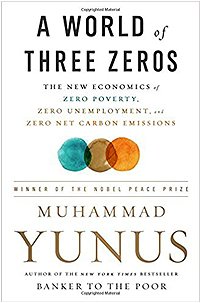Yunus takes microfinance to New York
Financial TimesOn the second floor of a run-down building in Queens, squeezed between a sari boutique and a tiny store selling Bollywood DVDs, are two rooms – rented for $1,500 a month – whose occupants have been sent from Bangladesh to end poverty in the US.
These are the offices of the first US outpost of the Grameen Bank, an organisation set up by Muhammad Yunus, the Nobel peace prize winner, and credited with turning the Bangladeshi bank into a revolutionary weapon against global poverty.
The pilot in the US is the first in a developed country, and Mr Yunus plans to use the country as a testing ground for his methods.
“If it makes an impact in the USA, then the whole world will come around . . . because you have gone to the toughest fort, and if you can conquer that, then the rest of it gets easier,†said Mr Yunus.
After beginning in Bangladesh more than 30 years ago with loans of just a few dollars, Mr Yunus, a US-trained economist, has built the bank into a behemoth that is one of the impoverished country’s main financial institutions.
By making tiny loans to very poor women who had no access to lending from financial institutions, the Grameen Bank helped them set up small enterprises that would lift them out of poverty. The model has now been copied in more than 40 countries around the globe.
The US presents a ripe market for Grameen, Mr Yunus claims, because it has a large population that sits outside the formal banking system. As many as 28m people, earning $510bn a year, do not have any relationship with a financial institution, according to the Federal Deposit Insurance Corporation.
Those who have no bank accounts rely on fringe banking services such as cheque cashers, pawnshops and payday lenders.
Payday lenders can charge as much as 1,560 per cent for a week’s cash ad- vance against forward-dated cheques, according to the Consumer Federation of America. Payday lenders made $48bn (€33bn, £24bn) in loans last year, while pawnshops’ business has been soaring as the US heads into a slowdown.
“You have the payday loans, you have the cheque cashing companies, and they’re flourishing, and they are pretty bold, the big advertisements in the newspapers, big ads on television . . . so this shows how much [of a] gap there is in the system,†Mr Yunus said.
In just over a month Grameen has lent out more than $50,000 to 35 women, including Bangladeshis, Dominicans, Haitians and Columbians, without bank accounts. The loans have gone towards building clothing, hairdressing and manicure businesses. Loans start at $1,500 dollars and rise to $6,000 as borrowers display their ability to repay, all at about 16 per cent interest.
The aim is to begin with a local self-sustaining organisation in New York and then expand to other areas.
“You do it one step at a time,†says Vidar Jorgensen, president of Grameen America. “But McDonald’s [restaurant] is a simple business unit. If it works in one neighbourhood, it should be able to work in any neighbourhood, but the key is to get that one unit right.â€
Microfinance is not new to the US. There are already about 750 organisations in the country, of which about 200 make loans.
Project Enterprise, a microfinance organisation in New York based on Grameen principles, has seen some notable successes. The organisation helped Egypt Lawson, a young African-American woman from Harlem, set up a wig business with a $1,700 loan, and four years later her company has a $3.2m turnover.
As yet most US microfinance organisations have struggled to survive without constant infusions of cash from outside donors. Grameen’s US operation has been started with $600,000 in grants from H&R Block, the US tax adviser, and other donors, but it plans to become self-sustaining in five years.
The obstacles are large. Mr Yunus admits “there is no legal framework to create a microcredit bank†and that “vested interests†in the US financial system oppose change. But he says that if laws cannot be created, Grameen could “piggy back†on a larger bank. US welfare law also discourages recipients of social benefits from earning money on the side.
Critics argue that the US is not ideal for microfinance because red tape and the tax system makes it harder to set up businesses there than in developing countries, and competition is much fiercer from the local Wal-Mart.


